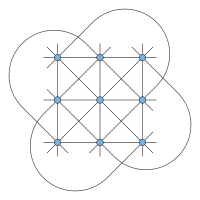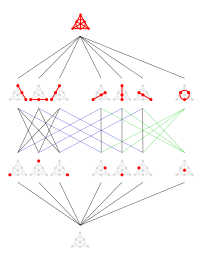Finite geometry
A projective plane geometry is a nonempty set X (whose elements are called "points"), along with a nonempty collection L of subsets of X (whose elements are called "lines"), such that: An examination of the first two axioms shows that they are nearly identical, except that the roles of points and lines have been interchanged.This suggests the principle of duality for projective plane geometries, meaning that any true statement valid in all these geometries remains true if we exchange points for lines and lines for points.Affine and projective planes of order n exist whenever n is a prime power (a prime number raised to a positive integer exponent), by using affine and projective planes over the finite field with n = pk elements.The non-existence of a finite plane of order 10 was proven in a computer-assisted proof that finished in 1989 – see (Lam 1991) for details.Individual examples can be found in the work of Thomas Penyngton Kirkman (1847) and the systematic development of finite projective geometry given by von Staudt (1856).The first axiomatic treatment of finite projective geometry was developed by the Italian mathematician Gino Fano.In his work[2] on proving the independence of the set of axioms for projective n-space that he developed,[3] he considered a finite three dimensional space with 15 points, 35 lines and 15 planes (see diagram), in which each line had only three points on it.[4] In 1906 Oswald Veblen and W. H. Bussey described projective geometry using homogeneous coordinates with entries from the Galois field GF(q).The study of these higher-dimensional spaces (n ≥ 3) has many important applications in advanced mathematical theories.The geometric dimension of the space is said to be n if that is the largest number for which there is a strictly ascending chain of subspaces of this form: A standard algebraic construction of systems satisfies these axioms.Two of the seven non-isomorphic solutions to this problem can be stated in terms of structures in the Fano 3-space, PG(3,2), known as packings.A packing of PG(3,2) consists of seven disjoint spreads and so corresponds to a full week of arrangements.





GeometryProjectingsphereBranchesEuclideanNon-EuclideanEllipticSphericalHyperbolicNon-Archimedean geometryProjectiveAffineSyntheticAnalyticAlgebraicArithmeticDiophantineDifferentialRiemannianSymplecticDiscrete differentialComplexDiscrete/CombinatorialDigitalConvexComputationalFractalIncidence Noncommutative geometryNoncommutative algebraic geometryDimensionStraightedge and compass constructionsDiagonalOrthogonalityPerpendicularParallelVertexCongruenceSimilaritySymmetryZero-dimensionalOne-dimensionalsegmentLengthTwo-dimensionalPolygonTriangleAltitudeHypotenusePythagorean theoremParallelogramSquareRectangleRhombusRhomboidQuadrilateralTrapezoidCircleDiameterCircumferenceThree-dimensionalVolumecuboidCylinderDodecahedronIcosahedronOctahedronPyramidPlatonic SolidTetrahedronTesseractHypersphereGeometersAryabhataAlhazenApolloniusArchimedesAtiyahBaudhayanaBolyaiBrahmaguptaCartanCoxeterDescartesEuclidGromovHilbertHuygensJyeṣṭhadevaKātyāyanaKhayyámLobachevskyManavaMinkowskiMinggatuPascalPythagorasParameshvaraPoincaréRiemannSakabeal-TusiVeblenVirasenaYang Huial-YasaminList of geometersgeometricfinitepointsEuclidean geometrypixelsaffine spacesMöbius or inversive planesLaguerre planesBenz planesinversive geometrieslinear algebravector spacesfinite fieldprojective planesGalois geometriesprojective spaceisomorphicnon-Desarguesian planesaffine plane